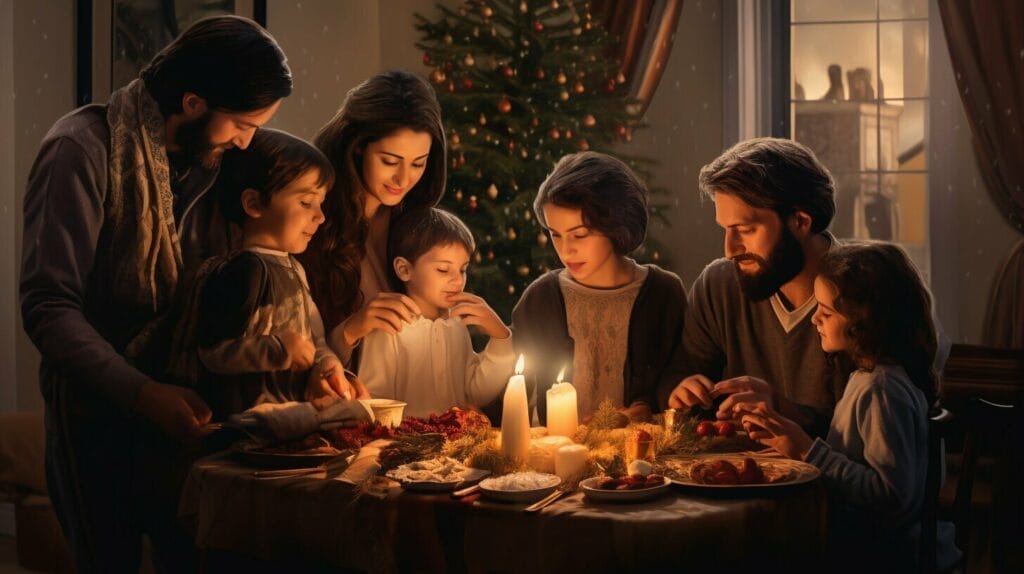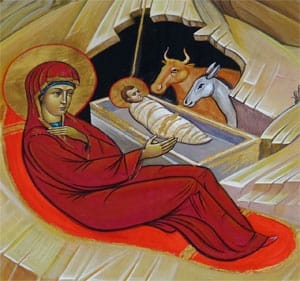Orthodox Christmas Traditions: A Blend of Ancient Rituals and Modern Practices
As the holiday season approaches, many people celebrate Christmas with tree decorations, exchanging presents, and festive meals. However, Orthodox Christmas traditions offer a unique and rich cultural experience that dates back centuries. These customs are rooted in the Eastern Orthodox Christian faith, which has spread across the globe, bringing with it unique customs and practices.

We explore the origins and different traditions associated with Orthodox Christmas, the celebrations that take place across the world, and how these traditions have evolved over time. We will also explore the symbolism and meaning behind these customs, as well as practical ways to incorporate them into your own holiday celebrations.
Key Takeaways:
- Orthodox Christmas traditions offer a unique blend of ancient rituals and modern practices.
- These customs are rooted in the Eastern Orthodox Christian faith, with roots tracing back centuries.
- Celebrations take place across different countries and communities, each with their own unique customs.
- It is possible to incorporate Orthodox Christmas traditions into your own holiday celebrations, regardless of your religious background.
- Exploring and embracing these traditions can bring added depth and meaning to your holiday season.
The Origins of Orthodox Christmas Traditions
Orthodox Christmas traditions have a rich history that dates back to the early days of Christianity. The Eastern Orthodox Church played a pivotal role in shaping these customs and rituals, which have been passed down over the centuries.
The celebration of Christmas on January 7th, rather than December 25th, is due to the use of the Julian calendar by the Orthodox Church. This dates back to the Roman Empire and was adopted by the early Christian Church.
The Nativity Fast, also known as the Advent Fast, is a period of fasting that precedes the feast of Christmas. The fast lasts for 40 days, symbolizing the 40 days that Jesus spent in the wilderness before beginning his ministry. During this time, Orthodox Christians abstain from meat, dairy, and other animal products.
The liturgy and worship services during Orthodox Christmas are steeped in tradition and ritual. The Orthodox Church uses the ancient Greek language in many of its services, adding to the sense of timelessness and history.
Overall, the origins of Orthodox Christmas traditions reflect a deep connection to the history of Christianity and a commitment to honoring its ancient roots.
A Global Celebration: Orthodox Christmas Traditions Around the World
Orthodox Christmas is celebrated in various countries across the world, each with its unique traditions and practices. From Russia and Greece to Serbia and Egypt, discover how diverse cultures observe this sacred holiday.
In Russia, Orthodox Christmas is called Rozhdestvo and celebrated on January 7th, following the Julian calendar. The celebrations include lighting candles, singing hymns, and partaking in a festive meal consisting of traditional dishes such as kutya and borscht.

In Greece, the holiday is known as Christougena and is celebrated on December 25th, following the Gregorian calendar. Greek Orthodox Christians attend church services, decorate their homes with lights and ornaments, and prepare special sweet treats like melomakarona and kourabiedes for their loved ones.
In Serbia, Orthodox Christmas is celebrated on January 7th and is known as Božić. The celebrations involve burning an oak branch, symbolizing the Yule log, and attending church services. Families gather to share a festive meal and exchange gifts, while children go caroling door-to-door.
In Egypt, Coptic Orthodox Christians celebrate Christmas on January 7th, attending church services and feasting on traditional dishes like fatta and kahk. The holiday is particularly significant for the country’s Christian minority, who face discrimination and persecution.
Regardless of the country, Orthodox Christmas traditions are steeped in rich cultural heritage and deep spiritual meaning, bringing joy and unity to communities around the world.
Traditional Orthodox Christmas Customs
Orthodox Christmas is steeped in rich traditions that have been passed down for centuries. These customs are an integral part of the holiday celebration, and many families and communities take great joy in observing them. Here are some of the most traditional Orthodox Christmas customs:
The Fasting Period
The fasting period leading up to Christmas is a time for spiritual reflection and preparation. It begins on November 15th and lasts for forty days, during which time the faithful abstain from meat and dairy products, as well as other indulgences.
The Blessing of the House
On Christmas Eve, it is traditional to have the family home blessed by a priest. The priest will sprinkle holy water throughout the house, asking for God’s blessings and protection.
The Lighting of Candles
On Christmas Eve, candles are lit in homes and churches to symbolize the light of Christ coming into the world. The candles are typically left burning throughout the night and into Christmas morning.
The Preparation of Special Festive Meals
Food is an important part of Orthodox Christmas celebrations, and families often prepare special meals to share with loved ones. Traditional dishes include kutia, a sweet grain pudding, and varenyky, a type of dumpling filled with cabbage or potatoes.
The Exchange of Gifts
Just as in many other cultures, gift-giving is a significant part of Orthodox Christmas. It is traditional to exchange gifts with friends and family members on Christmas Day, symbolizing the gifts brought to the baby Jesus by the Magi.
These traditional customs are just a few of the many ways in which Orthodox Christians celebrate Christmas. They help to create a sense of community and connection to the past, while also honoring the deep spiritual significance of the holiday.
The Iconic Symbolism of Orthodox Christmas
Orthodox Christmas is a celebration that is rich in symbolism and holds a deep spiritual significance for believers. The icons and religious imagery associated with this holiday are among its most iconic and recognizable features.
The Nativity is one of the most important religious symbols associated with Orthodox Christmas. Depictions of the holy family in the manger are found throughout Orthodox iconography, often accompanied by shepherds and the three wise men. This symbol represents the miraculous birth of Jesus Christ, celebrated by Christians around the world.

The Virgin Mary is another important religious figure whose image is widely associated with Orthodox Christmas. She is often depicted holding the baby Jesus, representing the profound love and devotion of a mother for her child. This symbol is central to the celebration of Orthodox Christmas, reminding believers of the great sacrifice and love at the heart of the Christian faith.
Other biblical figures that are commonly depicted in Orthodox iconography include Saint Nicholas, who is the patron saint of children and is associated with gift-giving during the Christmas season. Symbols such as the star of Bethlehem and the angels are also found in Orthodox Christmas iconography, representing the divine presence and guidance that led the shepherds and wise men to the manger.
Throughout the Orthodox Christmas celebration, believers often incorporate these symbols and imagery into their spiritual practices, including lighting candles, singing hymns, and creating beautiful decorations. By embracing the iconic symbolism of Orthodox Christmas, believers are able to connect with the deeper spiritual meaning of this sacred holiday and find renewed inspiration and meaning in their faith.
Modern Adaptations of Orthodox Christmas Traditions
As with most cultural traditions, Orthodox Christmas customs and practices have evolved over time to incorporate modern practices, while still honoring their historical roots.
One example of this is the use of technology in church services. In some communities, smartphones and tablets are used to follow along with the liturgy and access prayer books and religious texts. This allows for a more interactive and engaging experience, especially for younger generations.
Another adaptation is the use of social media and digital platforms to share the holiday spirit with loved ones near and far. Families can connect through video calls and share pictures and messages on social media, making the holiday season more inclusive and accessible.
While modern adaptations may seem like a departure from traditional customs, they can actually enhance the spiritual experience of Orthodox Christmas. By embracing new ways of celebrating and connecting with others, individuals can renew their sense of faith and share the joy of the holiday season with those around them.
Special Rituals and Ceremonies on Orthodox Christmas
Orthodox Christmas is steeped in beautiful and meaningful rituals and ceremonies that enhance the spiritual experience. Let’s explore some of the most important ones:
The Midnight Liturgy
One of the most significant rituals of Orthodox Christmas is the midnight liturgy, which takes place on the eve of the feast day. This solemn service commemorates the birth of Jesus Christ and the message of hope and salvation that he brought to the world. The liturgy is held in churches across the globe, and typically begins in the late hours of December 24th and ends in the early hours of December 25th.
The Procession of the Cross
The procession of the cross is another integral part of Orthodox Christmas celebrations. This ceremony takes place after the midnight liturgy, and involves a priest carrying a cross out of the church and around the building. As the cross is carried, the faithful follow, holding candles and singing hymns in praise of Christ’s birth.
The Blessing of the Water
The blessing of the water is a unique ceremony that takes place on the day of Orthodox Christmas. This ritual involves the priest blessing a body of water, such as a river or lake, by throwing a cross into the water and reciting a prayer. The faithful then immerse themselves in the water, which is believed to be infused with the power of Christ’s birth, and is said to have healing and protective properties.
These are just a few of the special rituals and ceremonies that make Orthodox Christmas such a meaningful and joyous celebration. By participating in these customs, you can deepen your appreciation for the spiritual significance of Christ’s birth and create a lasting connection to your faith.
Orthodox Christmas Traditions for Families and Children
Orthodox Christmas is a time for families and communities to come together and celebrate the joyous occasion of Jesus’ birth. For families with children, there are many customs and practices that can be enjoyed to make this holiday season even more memorable.
Decorating the Christmas tree: One of the most beloved traditions during Orthodox Christmas is decorating the Christmas tree. This usually takes place on Christmas Eve or a few days prior. Families can come together to hang ornaments, tinsel, lights, and other festive decorations on the tree. This is a fun way to involve children in the holiday preparations.
Singing carols: Another important tradition is singing Christmas carols. Families can gather together and sing traditional hymns such as “Silent Night” and “Joy to the World”. Children can also be taught new carols in different languages to help them appreciate the diversity of Orthodox Christmas traditions around the world.

Engaging in charitable acts: Orthodox Christmas is also a time for giving and helping those in need. Families can participate in charitable acts such as donating to a food bank, volunteering at a homeless shelter, or purchasing gifts for children in need. This helps children understand the importance of giving back and making a positive impact in their community.
Preparing special festive meals: During Orthodox Christmas, families prepare special meals that are enjoyed together. Children can help with the preparation of traditional dishes such as kutia, borscht, and perogies. This is a great way to spend time together and pass down family recipes from generation to generation.
By incorporating these Orthodox Christmas customs into your family’s holiday celebrations, you can create lasting memories and instill important values in your children.
Orthodox Christmas Traditions in the United States
If you live in the United States, you may be curious about how Orthodox Christmas is celebrated within your own community. While the customs and practices may vary depending on the specific denomination, there are some general traditions that are observed by Orthodox Christians across the country.
During the weeks leading up to Christmas, many Orthodox Christians observe a period of fasting, similar to the season of Lent. This time of spiritual preparation is meant to help individuals focus on the upcoming celebration of Christ’s birth.
On Christmas Eve, church services are held to commemorate the Nativity, often beginning at midnight and lasting several hours. The liturgy is accompanied by hymns, prayers, and readings from the Bible.
Many Orthodox Christians also participate in the tradition of the “blessing of the water,” which symbolizes the baptism of Jesus Christ and is typically performed on the day of Theophany, January 6th.
Several cultural festivals are also held in honor of Orthodox Christmas across the United States. These events showcase the rich traditions of various Orthodox communities, from Russian to Greek to Serbian to Egyptian. Visitors can enjoy traditional foods, music, and dances while learning more about the customs and practices associated with this important holiday.
In addition to these community-wide celebrations, families may also engage in their own personal traditions at home. This can include decorating a Christmas tree, exchanging gifts, or preparing special festive meals. Singing carols and engaging in acts of charity are also common ways for families to embrace the spirit of Orthodox Christmas.
Whether you are part of an Orthodox Christian community or simply interested in learning more about this rich cultural tradition, Orthodox Christmas offers a unique opportunity to connect with the deep spiritual roots of Christianity. By embracing these customs and practices, you can gain a deeper appreciation for the meaning and significance of this sacred holiday.
Embracing Orthodox Christmas Traditions: Bringing Meaning to Your Holiday Season
If you are looking to infuse your holiday season with deeper spiritual meaning, consider incorporating Orthodox Christmas traditions into your celebrations. These ancient practices, steeped in history and tradition, offer a unique perspective on the birth of Jesus Christ.
Whether you are of Orthodox faith or not, there are many ways to embrace these customs and rituals. For example, you can light candles and sing hymns, participate in charitable acts, or prepare a special festive meal. You can also attend church services, join in a procession of the cross, or witness the blessing of the water.
By embracing Orthodox Christmas traditions, you can tap into a profound sense of spirituality and connection to something greater than yourself. You can also honor the rich cultural heritage of these practices, which have been passed down for centuries.
Even if you don’t have an Orthodox community nearby, there are still ways to incorporate these traditions into your holiday season. You can research Orthodox Christmas customs and try them out for yourself. You can also attend cultural festivals or events that showcase these traditions and offer a glimpse into the vibrant community that practices them.
Embracing Orthodox Christmas traditions can add depth and meaning to your holiday season, regardless of your religious background. It can also help you connect with others who share a similar appreciation for these ancient practices. So why not give it a try and see for yourself the beauty and richness of Orthodox Christmas celebration?
FAQ
Q: What are Orthodox Christmas traditions?
A: Orthodox Christmas traditions are a unique blend of ancient rituals and modern practices that are observed by Eastern Orthodox Christians to celebrate the birth of Jesus Christ.
Q: What is the history behind Orthodox Christmas traditions?
A: Orthodox Christmas traditions have their roots in early Christianity and have been passed down for centuries. These customs are influenced by Eastern Orthodox Christianity and hold deep cultural and religious significance.
Q: How is Orthodox Christmas celebrated around the world?
A: Orthodox Christmas is celebrated in different ways across the globe. Various countries have their own customs and practices, such as Russia with its iconic midnight liturgy, Greece with its festive meals, and Egypt with its colorful processions.
Q: What are some traditional Orthodox Christmas customs?
A: Traditional Orthodox Christmas customs include fasting before the feast, lighting candles, and singing hymns. Other customs include blessing the house, exchanging gifts, and preparing special festive meals.
Q: What symbolic meanings are associated with Orthodox Christmas?
A: Icons and religious imagery play a significant role in Orthodox Christmas celebrations. These symbols represent the Nativity, the Virgin Mary, and other biblical figures, carrying deep spiritual significance for Orthodox Christians.
Q: How have Orthodox Christmas traditions adapted to modern times?
A: Orthodox Christmas traditions have evolved to incorporate modern practices. This includes technological advancements in church services and innovative ways of sharing the holiday spirit within Orthodox communities.
Q: What are some special rituals and ceremonies on Orthodox Christmas?
A: Orthodox Christmas is marked by unique rituals and ceremonies. These include the midnight liturgy, the procession of the cross, and the blessing of the water, all of which enhance the spiritual experience of the holiday.
Q: How can families and children engage in Orthodox Christmas traditions?
A: Families and children can participate in Orthodox Christmas traditions by decorating the Christmas tree, singing carols, and engaging in charitable acts. These activities help bring families and communities together during the holiday season.
Q: How are Orthodox Christmas traditions observed in the United States?
A: In the United States, Orthodox Christmas traditions are observed by diverse communities from various Orthodox denominations. Vibrant church services and cultural festivals showcase the unique ways in which this holiday is celebrated across the nation.
Q: How can individuals incorporate Orthodox Christmas traditions into their own celebrations?
A: Regardless of religious background, individuals can embrace Orthodox Christmas traditions by learning about their spiritual significance and incorporating them into their holiday celebrations. This can add depth and meaning to the Christmas season.




